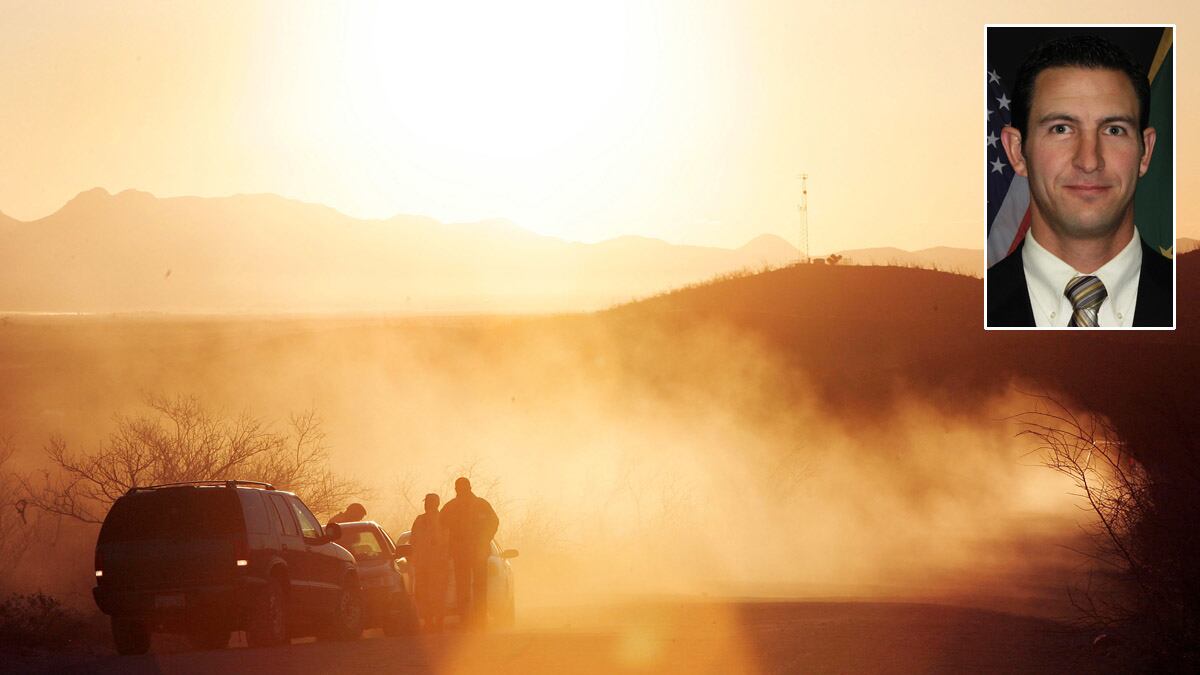John Ladd’s ranch straddles the Arizona-Mexico border for 10 miles to the south. In the north, the ranch sits on State Route 92.
He is on the front line of the drug war as smugglers regularly break through his fences to get from the border to the state road.
When Ladd had a problem, he knew he could call U.S. Border Patrol Agent Nicholas Ivie.
As Ladd sat on the back of his red pickup truck, he recalled how Ivie programmed his cellphone number into his phone so he could call him directly.
“I had the ultimate trust in him,” said Ladd lamenting the death of Ivie, 30. “He was a perfect example of an all-American boy.”
On late Friday afternoon, the FBI confirmed that there are strong preliminary indications the death of Ivie and the nonfatal shooting of a second Border Patrol agent were “the result of an accidental shooting incident involving only the agents.”
Evidence in the case, including ballistics, indicate the Border Patrol agents may have exchanged fire with each other. Ivie was with two other agents early Tuesday morning in rugged terrain investigating an alarm that went off on a sensor east of Naco, Ariz.
Ivie, who was with the Border Patrol for four years, worked in Cochise County, which sits in the pathway of the drug war. It was initially believed that he was shot by smugglers or traffickers. Mexican officials even announced they had arrested two suspects in the case.
Ivie’s killing stirred emotions and raised concerns about the risks of living and working along the U.S.-Mexico border. Some residents and law enforcement officials said the region needs more resources to fight the drug cartel.
Since 2008, more than 1,000 additional Border Patrol agents have been added to the Tucson area district that covers around 260 miles of the border including Cochise County, which sits on 80 miles of the border.

The Border Patrol presence is evident driving from Texas through New Mexico and into Arizona. Agents patrol the sides of the roads looking for tracks, helicopters fly overhead, and along every state road heading north from the border there is a stop where agents check immigration papers and dogs sniff cars.
I traveled here from the Texas border where I am researching the history of my great grandfather, Candelario Ortiz, a deputy sheriff who was the first lawman shot in the line of duty in Dimmit County. That was back in 1913, and he was captured, tortured and killed by Mexican gun smugglers trying to bring arms from Texas into Mexico to foment the Revolution.
The story remains much the same today as drugs, people and weapons are smuggled across the border. The drug war shows no signs of abating in Mexico and the appetite for drugs in the United States remains high.
Ladd, who is close friends with several local Border Patrol agents, said they don’t have the equipment or technology the need to do their jobs. He also said they need more agents in the terrain away from the roads.
“Homeland Security says the border is safer than it’s ever been. It’s a lie,” said Ladd, who sees immigrants or drug smugglers race across his property almost daily.
Ivie’s death stoked tensions here in Cochise County where ranchers have long complained about border crossers trespassing on their land, stealing food and clothes from their homes and leaving behind trash that their livestock can choke on and die from eating.
Tensions escalated back in 2010 when a well-known rancher, Robert N. Krentz Jr., 58, was found fatally shot on his ranch in this same region.
The trail of evidence led to the Mexican border but no arrests have been made in that case, according to the Cochise County Sheriff’s Office.
In the border area of Cochise County, there is a large fence near Naco and another fence 25 miles east at Douglas. But there are other parts of the county’s border with a wire fence, a pole fence, or no fence at all, said Carol A. Capas, a spokeswoman for the sheriff’s office.
“We need to find a way to secure the border,” said Capas.
The sheriff’s department had previously received federal funding and grants to work with other law enforcement agencies. But in July it created its own independent narcotics team to combat trafficking.
This was a solution put forward by the late Sheriff Larry Dever, a supporter of Arizona’s controversial immigration law SB 1070, who was killed in a single-car car accident a few weeks ago.
This bad news and the death of Ivie have shaken the county that is the size of Connecticut and Rhode Island combined. Its main jail was built to hold 165 inmates, and it is over capacity at 260, among them smugglers and undocumented immigrants, Capas said.
The sheriff’s department, with 80 officers, works closely with the Border Patrol, especially in reaching more remote parts of the county for emergency calls.
The number of Border Patrol agents in the greater Tucson region that includes Cochise County has increased from around 3,000 in fiscal year 2008 to 4,300 in fiscal year 2012. They only break the numbers down by region, not by county, said Brent Cagen, with the U.S. Border Patrol.
A new 92,000 square-foot border office in Bisbee, Ariz., a few miles north of the border opened just two weeks ago. It was named for Border Patrol agent Brian Terry who was killed in 2010 in Arizona.
His death revealed the “gunwalking” controversy that the U.S. Bureau of Alcohol, Tobacco and Firearms allowed illegal guns to be purchased and smuggled into Mexico so that they could follow criminals in a program known as Fast and Furious.
Working at the border is a dangerous job. More than 14 Border Patrol agents have died in the line of duty since 2008 and 26 have been killed since 2002.
Naco is located around 30 miles south of Tombstone, where one of the most famous gun battles happened at the O.K. Corral.
This region was once known for mining copper and gold. Nearby Bisbee is a cute tourist down that offers tours of the old mine.
But the region also is a popular route for drug mules who carry backpacks with as much a 150 pounds of marijuana on foot through the Mule Mountains into the United States. They drop the backpacks to waiting cars and often bring the backpacks full of drug money back to Mexico, Capas said.
Today a border fence snakes up the land that divides Naco, Ariz., from Naco, Mexico.
The unincorporated Naco, Ariz., is so small that the only open businesses on a recent afternoon were a local bar and an auto mechanic. There is also a golf course next to a trailer park.
There was time when there was no fence, recalled Leonel Urcadez, who owns the only bar in town.
“Before you could walk around freely,” said Urcadez, 59, who as a child walked back and forth to Mexico to go grocery shopping.
The area was a military outpost during the Mexican Revolution. The first modern fence in Naco was erected in the early 90s.
“But within 12 hours there were ladders welded on the other side,” Capas said.
Now in order to walk across you need proof of U.S. citizenship or residency. Urcadez said adding additional Border Patrol agents doesn’t solve the problem.
“If they want to come, they can come. And there’s no way the Border Patrol can stop it,” Urcadez said. “Any 10 foot ladder would trump an eight-foot fence.”
On the Mexican side, there is a thriving business district filled with markets, taquerias, and other shops. Many of the Mexicans work in a nearby copper mine, while those with immigration papers travel into Arizona for work.
Flags at the border crossing and private homes fly at half-mast in honor of Ivie.
He was married, the father of two small children and active in the Mormon church. A former resident of Provo, Utah, he learned Spanish as a teenager on a mission trip in Mexico City.
His family members spoke at a press conference Thursday. They didn’t talk about the investigation but about the generosity and kindness of Ivie.
His brother recalled an incident where he came across a group of immigrants in the desert and there was a pregnant woman with no shoes and her feet were badly cut. He carried the woman a mile and a half to safety.
“He really did love the people that he worked with,” said his brother Chris Ivie. “He was a hero.”





